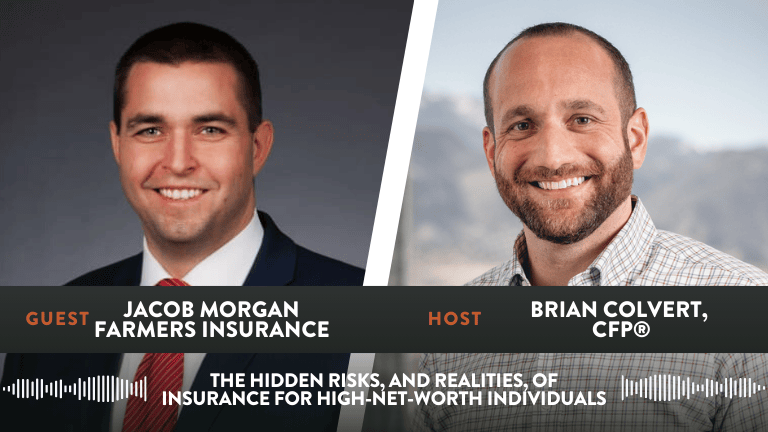b For high-net-worth individuals, wealth offers a sense of freedom, security, and choice. But with greater assets comes greater risk. While insurance is often seen as a check-the-box necessity, the truth is that many affluent individuals are unknowingly underinsured. This leaves them exposed to potential financial disaster in the event of a major claim.
Today we’re breaking down the hidden risks and how high-net-worth individuals can better protect their homes, vehicles, and lifestyles with the right insurance strategies. Drawing from a recent conversation with Jacob Morgan, a top 1% Farmers Insurance agent and President’s Council member, we’ll uncover the current trends, common mistakes, and smarter moves you should be making today.
Listen Now:
iTunes | Spotify | iHeartRadio | Amazon Music
—–
Why Standard Insurance Isn’t Built for the Affluent
Most people begin their insurance journey by shopping for the cheapest premium. It makes sense when you’re starting out. But as your assets grow, that approach quickly becomes dangerous.
Standard policies often have coverage caps that don’t align with the true value of luxury homes, exotic cars, or high-end personal items. Additionally, claims service, deductibles, and replacement cost policies may not be designed for unique needs.
Jacob Morgan puts it plainly: “If you’re worth $10 million and living in a fire-prone area with a custom-built home, you’re in a totally different risk category. You’re not just another house on the block. You’re a one-of-a-kind risk.”
The Reinsurance Crisis: Why Premiums Are Skyrocketing
One of the key drivers of rising insurance premiums in recent years is the cost of . Reinsurance is essentially insurance for insurance companies. When disasters like hurricanes, wildfires, and massive hailstorms happen, the losses get passed up the chain—and ultimately, back down to consumers.
In 2023 alone, the insurance industry lost $43 billion. By mid-2024, the industry had already hit that figure again. Reinsurance markets are tightening, especially in high-risk zones like:
- California (wildfires, earthquakes)
- Florida (hurricanes)
- Colorado (hail, wildfires)
- Texas (wind, flood)
These macro pressures are pushing premiums higher, and in some cases, making coverage harder to find altogether. For high-net-worth individuals, this means more scrutiny and significantly higher costs to insure homes in these areas.
Why Wealthy Individuals Are Hit Harder
Affluent clients often find themselves on the losing end of insurance pricing, but not by accident. The very things that make luxury living so desirable—beautiful locations, expansive properties, custom features—also make them high-risk to insure. Insurers are increasingly scrutinizing these properties and passing along higher costs to cover the growing risks and potential losses. Here’s why:
- Aggregation of Risk: Insuring a $20 million mansion is not the same as insuring ten $500,000 homes. A single loss can devastate a carrier’s bottom line.
- Location, Location, Risk: Luxury homes tend to be in scenic, exclusive areas—on the coast, in the mountains, or in rural getaways. These spots also happen to be more vulnerable to disasters and far from emergency services.
- Luxury = Higher Replacement Costs: A tile roof on a million-dollar home isn’t just more expensive—it can be exponentially more expensive. Add in custom cabinetry, imported finishes, and high-end tech, and you’re looking at rebuild costs far beyond what standard policies account for.
Common Insurance Mistakes High-Net-Worth Individuals
Despite having the means to afford proper protection, many wealthy individuals unknowingly fall into common insurance traps. These oversights often stem from a set-it-and-forget-it mentality, or from applying the same logic they used in their early financial lives. Let’s explore the most frequent mistakes and how to avoid them.
- Staying with the Same Policy for Too Long: Jacob shares that before he opened his agency, he had the same policy for 12 years without ever reviewing it. He later discovered major gaps in coverage. Your lifestyle evolves—your insurance should too.
- Chasing the Lowest Premium: While it might be tempting to price-shop insurance the same way you do flights or hotel rooms, this can lead to inadequate coverage. Insurance companies don’t create all policies equally—especially when it comes to endorsements and exclusions.
- Low Deductibles on High-Value Assets: Affluent individuals often keep deductibles low out of habit, but this can cost you thousands in premiums. Raising deductibles on high-value items like homes and luxury vehicles can significantly reduce your annual costs while making sense for your cash flow.
- Overinsuring Market Value Instead of Rebuild Cost: Many homeowners assume they should insure their home for its market value. In reality, insurance covers rebuild costs, not what Zillow says your home is worth.
- Skipping Liability and Umbrella Coverage: As wealth grows, so does visibility and the likelihood of being targeted in a lawsuit. Umbrella policies can be an inexpensive safeguard—often as little as $500 per year for millions in added protection.
Smarter Insurance Strategies for High-Net-Worth Individuals
If you’re building or preserving significant wealth, your insurance strategy needs to be just as sophisticated. It’s not only about coverage amounts. It’s about who manages your coverage, how often it’s reviewed, and what protections are in place when the unexpected happens. Here are some high-impact strategies that can dramatically improve your risk management approach.
- Work with an Agent Who Specializes in Affluent Clients: A knowledgeable agent can tailor policies based on your asset mix, lifestyle, and risk exposure. For example, a home in Vail, a yacht in Miami, and a classic car collection all require different layers of coverage and carriers that understand the nuances.
- Bundle Strategically: While bundling home and auto can provide discounts, sometimes splitting carriers is the better choice—especially if you have properties in multiple states.
- Review Policies Annually or After Major Life Changes: If you renovate your home, buy a new vehicle, acquire art, or add a vacation home, it’s time to review your policies. Even if nothing major changes, plan on an annual review to ensure you’re not overpaying or undercovered.
- Customize Coverage With Endorsements: High-value personal property often needs specialized endorsements. Think: collectibles, watches, wine collections, sports memorabilia, home offices, or smart-home systems. Avoid assuming that a standard policy fully covers these items.
- Embrace Higher Deductibles Where It Makes Sense: As Jacob suggests, if you can easily afford a $2,500 or $5,000 deductible on your home or car, consider increasing it. Use the savings to enhance your liability limits or invest in umbrella coverage.
- Invest in an Umbrella Policy: Liability claims can come from car accidents, injuries on your property, or even social media defamation. Umbrella insurance picks up where your primary coverage stops, providing extra peace of mind.
Jacob noted that in his book of business, only two umbrella claims have been made. Both were worth more than the premiums collected from hundreds of policies—and they saved the clients from serious financial harm.
Final Takeaway: Don’t Set It and Forget It
Insurance for high-net-worth individuals is not just a formality, it’s a strategic pillar of wealth protection. Unfortunately, too many people spend decades building wealth—only to risk it all on outdated or inadequate insurance coverage.
Here’s what to do next:
- Review your current policies with a trusted agent
- Assess your liability exposure, especially if you have multiple properties or vehicles
- Ask about umbrella policies, higher deductibles, and tailored endorsements
- Re-shop or review annually, especially if you live in a high-risk area
As Jacob Morgan put it, “Why would you go your whole life building wealth, only to lose it over a $500 insurance decision?” Well said.
Ready to Protect What You’ve Built?
When it comes to high-net-worth insurance, working with the right expert makes all the difference. Jacob Morgan and his team specialize in protecting complex, high-value portfolios—from luxury homes and vehicles to vacation properties and beyond. Whether you’re reassessing your current coverage or building a more strategic risk management plan, Jacob can help ensure your insurance is aligned with your wealth.
Already working with us on your financial plan? Perfect. We’ll collaborate directly with Jacob to create a seamless, coordinated strategy that protects both your assets and your future.
📞 Contact Jacob Morgan at (719) 576-2638
📧 Email: [email protected]
Just mention this blog/podcast so he knows we sent you!
 Client Login
Client Login


